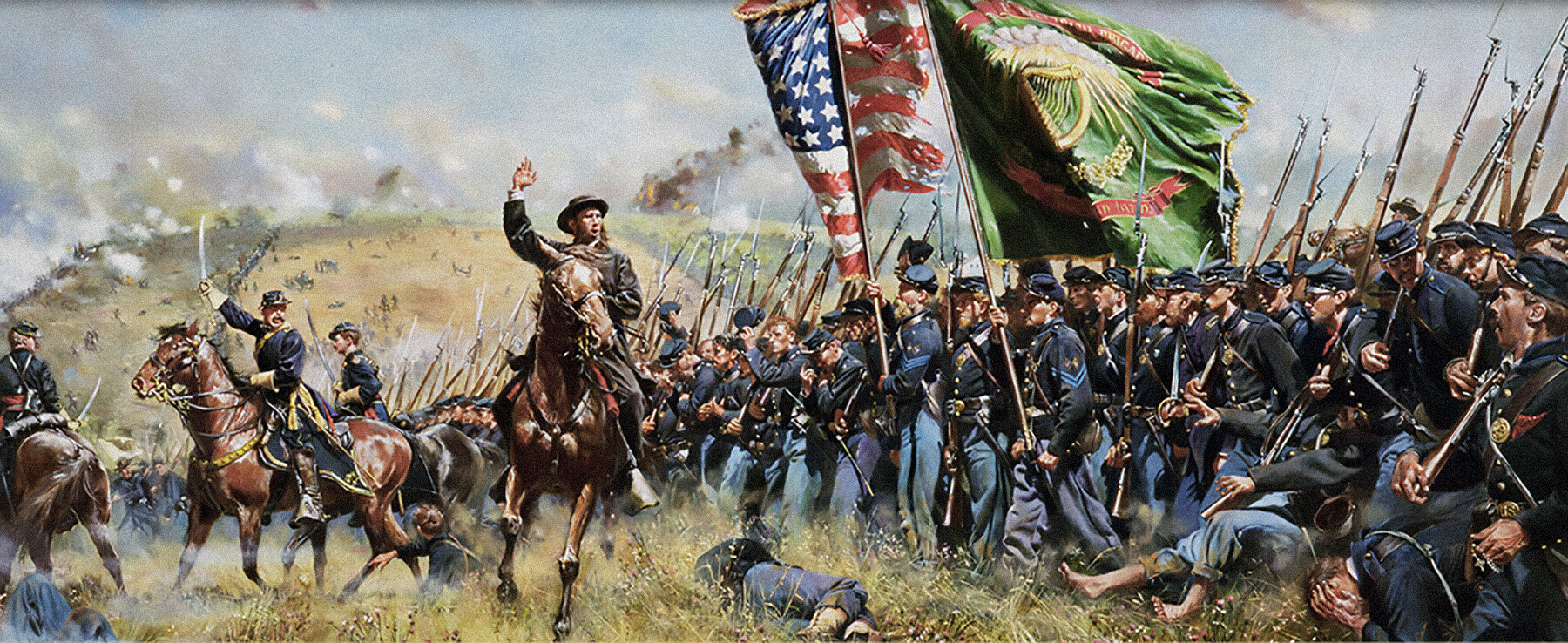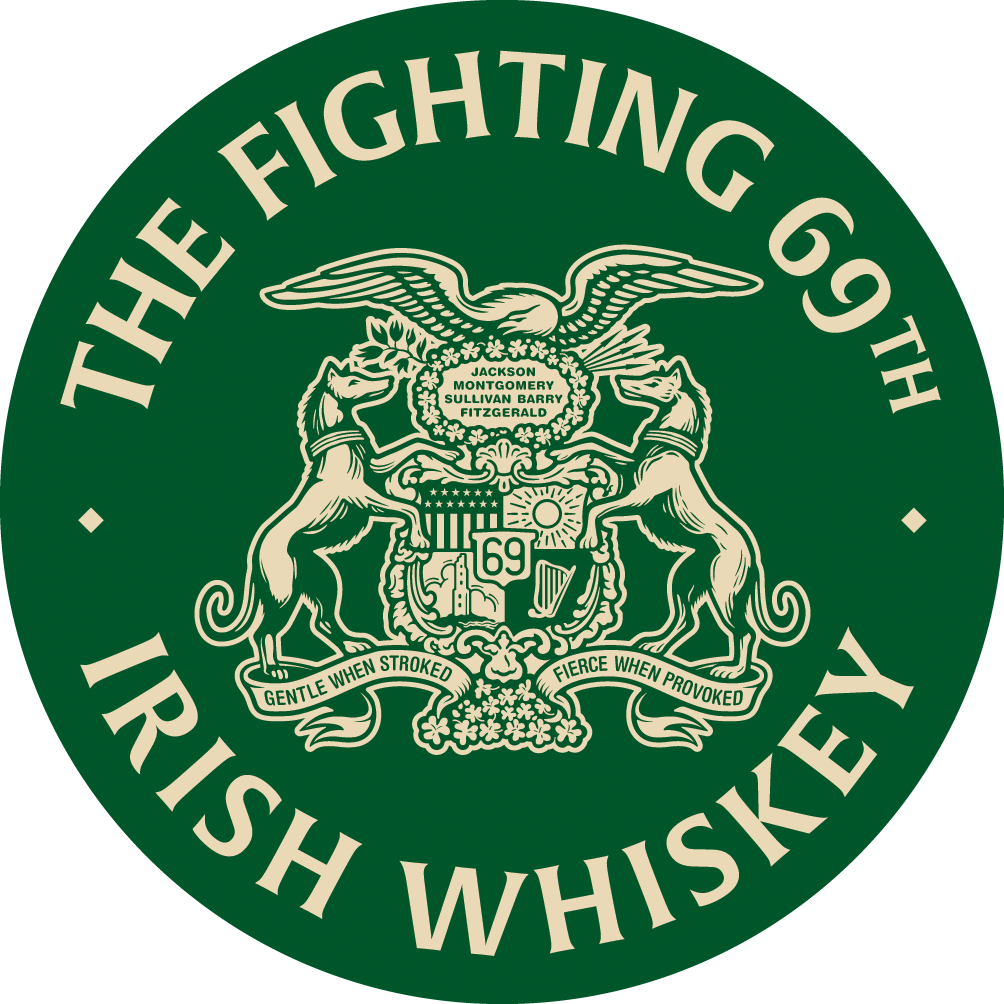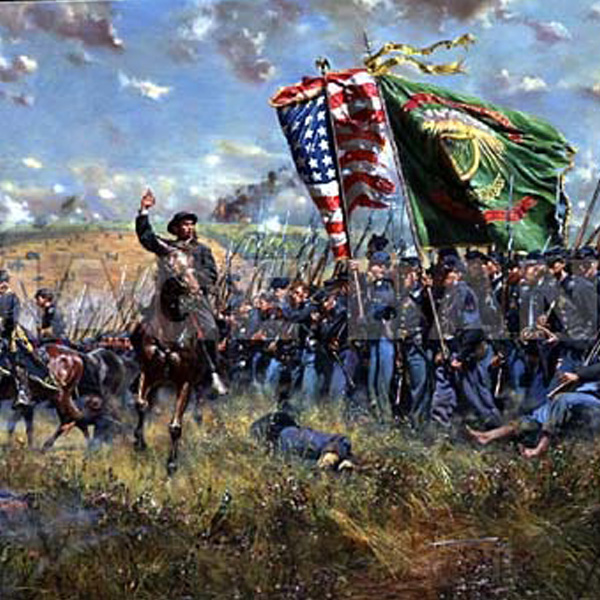
The regiment has seen combat in five wars: the American Civil War, World War I, World War II, the Iraq War and the Afghanistan War. It has also participated in 23 campaigns, so many that the staffs of its regimental colors are authorized to be one foot longer than normal to accommodate them all.
Founded in 1849 as the First Irish Regiment, the Fighting 69th initially wasn’t a U.S. military unit at all. Rather it was an all-Irish citizen militia, created to train young Irishmen living in New York City in military tactics, in hopes of eventually going back to Ireland to expel the British from the Irish homeland.

⋯ Civil War ⋯
CIVIL WAR
Called to Duty
Grand plans of freeing Ireland from British rule never materialized. But when the Civil War broke out in 1861, the First Irish volunteered to fight for the Union cause. Shortly reorganized as the 69th Infantry New York State Volunteers, the Irishmen quickly gained a reputation as the go-to unit for any tough — even hopeless — mission. The 69th first sees action at the Battle of First Bull Run in 1861.
Civil War
Thomas Meagher
Born in Waterford, Ireland, Thomas Francis Meagher (pronounced Mar) was a fiery Irish revolutionary who was convicted of sedition and nearly executed by the British in 1848. Finally exiled to Tasmania, he staged a daring escape, then made his way to New York where he became a hero of the Irish community.
Handsome, charismatic and highly social, Meagher shortly earned his U.S. citizenship, and then a law degree. By the 1860’s he’d become interested in U.S. politics. He joined the U.S. Army, and — after initially siding with the Confederacy — joined the Union Army and soon became an officer. After leading the 69th in the Battle of First Bull Run he was promoted to the rank of brigadier general. Meagher went on to lead Irish Brigade through some of the fiercest battles of the Civil War, including the Seven Days’ campaign, Antietam, Fredericksburg and Chancellorsville.
The city of Waterford, Ireland, celebrates their native son every year at the Tricolour Celebration in June, at the place of his birth, the Granville Hotel on the Quay. The celebration is attended by dignitaries from the Irish Parliament, as well as guests from the Fighting 69th Regiment.
CIVIL WAR
“The Fighting 69th”
On July 1, 1862, Confederate forces marched on Union positions at Malvern Hill, near the Confederate capital of Richmond, Virginia. Leading the charge against the advancing Southern troops, the 69th forced the retreat of the famed Louisiana Tigers, and action that spurred Robert E. Lee himself to nickname the regiment "The Fighting 69th".
CIVIL WAR
Cheered by Yankee and Reb Alike
The 69th went on to distinguish itself in battle at Antietam in September 1862, but suffered grievous casualties at Fredericksburg that December, losing 512 out of 1,000 men. Cheered even by the Confederates for their courage under fire, the 69th's sustained uphill attacks demonstrated once again the unit's sheer determination in battle.
CIVIL WAR
Bloodied, Never Beaten
After the Battle of Chancellorsville in 1863, only 300 of the 69th's original recruits remained. After Gettysburg there were less than 60. But by the end of the summer of 1864 the regiment had been refreshed with new Irish volunteers. The 69th reentered the war in time to see General Lee surrender at Appomattox in April, 1865.
⋯ World War I ⋯
World War I
The 69th and The Great War
When America entered World War I, young men from New York's Irish neighborhoods rushed to fill the ranks of the old Fighting 69th. Renumbered as the 165th Infantry Regiment, the unit was sent to the Western Front in October 1917 as part of the 42nd "Rainbow" Division of the American Expeditionary Force under General John Pershing.
World War I
Father Francis Patrick Duffy
Known as "The Fighting Chaplain", Father Francis Patrick Duffy is a Fighting 69th legend. The most highly decorated clergyman in U.S. Army history, Duffy served as chaplain for the 69th Infantry in France during World War I. There he was typically seen under fire, unarmed, encouraging the men in battle and assisting medics as they recovered the wounded.
So critical was Duffy to the morale of the 69th (re-designated the 165th during World War I) that brigade commander, Brigadier General Douglas MacArthur, briefly considered promoting him to regimental commander.
Duffy considered every member of the Fighting 69th — whatever their background — an honorary Irishman. As he once said: "They are Irish by adoption, Irish by association, or Irish by conviction".[18]
After the war, in recognition of his bravery and leadership, Duffy was awarded the Distinguished Service Cross, the Distinguished Service Medal, the Conspicuous Service Cross, the Légion d'Honneur, and the Croix de Guerre. Duffy went on to serve as a pastor of Holy Cross Church near Times Square, the northern end of which is commemorated as Duffy Square. A monument to Father Duffy stands there to this day.
World War I
Rouge Bouquet
The 165th saw its first combat the following February, 1918, near the Rouge Bouquet section of the Parroy Forest near the village of Baccarat. The battle dragged on into early March, when a German bomb struck a dugout killing 21 men from the 2nd Battalion. The event was memorialized in Sgt. Joyce Kilmer's famous poem “Rouge Bouquet”.
Rouge Bouquet
Joyce Kilmer - 1886-1918
In a wood they call the Rouge Bouquet
There is a new-made grave to-day,
Built by never a spade nor pick
Yet covered with earth ten metres thick.
There lie many fighting men,
Dead in their youthful prime,
Never to laugh nor love again
Nor taste the Summertime.
For Death came flying through the air
And stopped his flight at the dugout stair,
Touched his prey and left them there,
Clay to clay.
He hid their bodies stealthily
In the soil of the land they fought to free
And fled away.
Now over the grave abrupt and clear
Three volleys ring;
And perhaps their brave young spirits hear
The bugle sing:
“Go to sleep!
Go to sleep!
Slumber well where the shell screamed and fell.
Let your rifles rest on the muddy floor,
You will not need them any more.
Danger’s past;
Now at last,
Go to sleep!”
There is on earth no worthier grave
To hold the bodies of the brave
Than this place of pain and pride
Where they nobly fought and nobly died.
Never fear but in the skies
Saints and angels stand
Smiling with their holy eyes
On this new-come band.
St. Michael’s sword darts through the air
And touches the aureole on his hair
As he sees them stand saluting there,
His stalwart sons;
And Patrick, Brigid, Columkill
Rejoice that in veins of warriors still
The Gael’s blood runs.
And up to Heaven’s doorway floats,
From the wood called Rouge Bouquet,
A delicate cloud of buglenotes
That softly say:
“Farewell!
Farewell!
Comrades true, born anew, peace to you!
And your memory shine like the morning-star.
Brave and dear,
Shield us here.
Farewell!”

World War I
“By God, it Takes the Irish!”
That May, the 165th helped stopped a major German advance at the Second Battle of the Marne. They engaged at Château-Thierry, forcing the Germans back across the river, but suffering heavy losses in the process. When other regiments declined to answer Douglas MacArthur's call to pursue retreating Germans, the 165th declared it would "consider an order to advance a compliment". MacArthur exclaimed: "By God, it takes the Irish when you want a hard thing done!"
World War I
Triumphant Return
Total casualties of the regiment during World War I amounted to 644 killed and 2,587 wounded. That said, 60 members of the 165th earned the Distinguished Service Cross. Three more were awarded the Medal of Honor, including its famed 1st Battalion commander, William Joseph Donovan.
On returning from France, Donovan said "The morale of the regiment has never been better. Formerly 85 percent of its strength were of Irish descent, and now it is only 50 percent, but the spirit of the old Fighting 69th is stronger than ever. The replacements, whether they are Jews, Italians, or other foreign descent, are more Irish now than the Irish!".
World War I
Lieutenant Colonel William Donovan
One of the Fighting 69th's most famous members, William "Wild Bill" Donovan is the only individual to have ever received all four of the United States' highest awards: The Medal of Honor, the Distinguished Service Cross, the Distinguished Service Medal, and the National Security Medal.
Donovan initially commanded the 1st Battalion, 165th Infantry during World War I, but was soon promoted to commander of the entire 165th Regiment. While serving in France he suffered a shrapnel wound in the leg and was nearly blinded by a mustard gas attack. His valor earned him the French Croix de Guerre as well as the Distinguished Service Cross for the assault on Aisne-Marne, later depicted in the movie "The Fighting 69th" starring James Cagney.
Donovan went on to serve in World War II and later headed the Office of Strategic Services (OSS), which was the precursor to the CIA. Considered the father of the CIA, a statue of Colonel Donovan stands in the lobby of the CIA headquarters in Langley, Virginia.
⋯ World War II ⋯
World War II
World War II & The Pacific
During World War II, the Fighting 69th again served with distinction. Still designated the 165th Infantry, the regiment served with the 27th Division (a division of New York State's National Guard that was placed under Federal command for the duration of the war). Following Pearl Harbor, the 165th was sent to California to defend the West Coast from possible Japanese attack. When those attacks failed to materialize, the unit was deployed to Hawaii in 1942.
World War II
“Makin taken”
The 27th was first assigned to defend the island of Kauai, but was shortly redeployed to Oahu to train for the 1943 landings on Butaritari Island in the Gilbert Islands. Landing on Butaritari in November, the 27th took Butaritari Village, defending it against a Banzai attack that night. Two days later, with the island secured, the 27th sends the signal: “Makin taken”.
World War II
Saipan
The 27th landed at Saipan in June 1944. Despite heavy Japanese opposition, the 27th's 2nd Battalion captured Aslito Airfield, while the 1st Battalion fought to control of the ridge between the airfield and Cape Obian. That accomplished, the 27th redeployed to Purple Heart Ridge, which they cleared despite heavy flanking fire.
World War II
Okinawa
In April 1945, the 27th Division arrived at Okinawa, serving as a floating reserve until Marines encountered the notorious Manchinato line on April 6th. A coordinated assault began on Manchinato on April 19th, with the 27th assigned to the right flank along the west coast of the island. All in all, the 69th lost 472 men over the course of the Second World War.
Kennedy’s Tribute
On June 28th, 1963, President John F. Kennedy addressed the Irish Parliament in Dublin, Ireland.
“The thirteenth day of September, 1862, will be a day long remembered in American history. At Fredericksburg, Maryland, thousands of men fought and died on one of the bloodiest battlefields of the American Civil War. One of the most brilliant stories of that day was written by a band of 1200 men who went into battle wearing a green sprig in their hats. They bore a proud heritage and a special courage given to those who had long fought for the cause of freedom. I am referring, of course, to the Irish Brigade. Today, in recognition of what these gallant Irishmen, and what millions of other Irish have done for my country, and through the generosity of the ‘Fighting 69th,’ I would like to present one of these flags to the people of Ireland.”

⋯ Cold War & After ⋯
Cold War & After
Cold War transitions
Following World War II, the 69th remained a National Guard unit, and was therefore not called up for either Korea or Vietnam. In 1993 the regiment briefly became the 69th Air Defense Artillery Regiment, however after protests from members of the unit and its many veterans, the 69th was returned to its traditional role as an infantry unit and given back its original regimental number: the 69th.
Cold War & After
Operation Noble Eagle
The Fighting 69th’s armory is located at Lexington Avenue and 25th Street in the Chelsea neighborhood of Manhattan. It’s therefore no surprise that the 69th was one of the first military units to respond to the September 11 attacks. Members of the regiment helped to secure Ground Zero that morning. Two were killed conducting rescue operations.
Cold War & After
Operation Iraqi Freedom
In May 2004, the Fighting 69th was placed under Federal command once again, this time for Operation Iraqi Freedom. Deployed overseas for the first time since World War II, the 69th patrolled Taji, Radwiniyah, and Baghdad, and helped suppress rocket and mortar attacks on the Green Zone and Camp Cooke. Overall, 19 members of the 69th were killed in action in Iraq, and 78 were wounded in action before the unit returned to New York in September, 2005.
Cold War & After
Irish on Parade
The March 2006, New York City dedicated the St. Patrick's Day Parade to the Fighting 69th. On 13 March 2008 the House of Representatives passed House Resolution 991 (H.Res.991) recognizing the 69th Infantry. The resolution was sponsored by Rep. Steve Israel (D-NY) and passed unanimously.
Cold War & After
Operation Enduring Freedom
In 2008 approximately 300 soldiers from the 69th deployed to Afghanistan as part of Task Force Phoenix, attached to the 27th Infantry Brigade Combat Team. There the 69th helped stabilize the Hindu Kush and train Afghan security forces. Four member of the 69th were killed in the process. While unit officially returned to New York in the summer of 2009, elements of the battalion — approximately 300 soldiers — returned to Afghanistan in 2012 as part of the regular rotation of National Guard units.
Cold War & After
Still fighting tough — and Irish by conviction
Today the 69th consists of a single light infantry battalion (1st Battalion, 69th Infantry Regiment) and is part of the 27th Infantry Brigade of the 42nd Infantry Division. The 69th devotion and courage continue to earn it pride of place at the front of New Yorks' Annual St. Patrick’s Day Parade. And while today the 69th is no more than 20% Irish, every member is considered an honorary Irishman. Father Duffy would be proud.
Cold War & After
The 69th Regiment Armory
A certified National Public Landmark, the 69th Regiment Armory spans a full Manhattan block. To this day houses the New York Army National Guard 1st Battalion, 69th Infantry Regiment headquarters. There, the Sixty-Ninth Infantry Regimental Staff conducts programs to preserve and educate visitors on the history, traditions, heraldry, lineage, armory, and historical artifacts of the Regiment. They also provide various forms of assistance to unit members, unit veterans, and their families.























